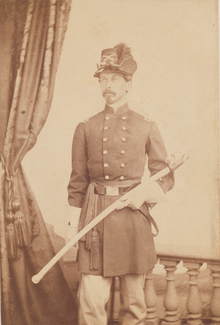
The Battle of Brandy Station, also called the Battle of Fleetwood Hill, was the largest predominantly cavalry engagement of the American Civil War, as well as the largest ever to take place on American soil. It was fought on June 9, 1863, around Brandy Station, Virginia, at the beginning of the Gettysburg Campaign by the Union cavalry under Maj. Gen. Alfred Pleasonton against Maj. Gen. J. E. B. Stuart's Confederate cavalry.
The 106th Pennsylvania was a volunteer infantry regiment which served in the Union Army during the American Civil War. It was part of the famous Philadelphia Brigade, which helped defend against Pickett's Charge in the Battle of Gettysburg.

George Childs Burling was a United States Union Army officer during the American Civil War, serving mostly as colonel and commander of the 6th New Jersey Volunteer Infantry. Burling was born in Burlington County, New Jersey, raised on his father's farm and educated at a private school in Norristown, Pennsylvania. He was a coal merchant and a militia officer before the war. Burling's militia company was mustered into the volunteer service for a three-month term in July 1861, but it became company F of the 6th New Jersey with a three-year enlistment on September 9, 1861. Burling became the regiment's major on March 19, 1862, and lieutenant colonel on May 7 of that year. Burling was wounded at the Second Battle of Bull Run in August 1862.

The 118th Pennsylvania Regiment was a volunteer infantry regiment in the Union Army during the American Civil War. They participated in several major conflicts during the war including the Battle of Gettysburg, Siege of Petersburg, and escorted the truce flag of Robert E. Lee at the Battle of Five Forks. The regiment was led by Colonel Charles Prevost until he was seriously injured at the Battle of Shepherdstown in which Lieutenant-Colonel James Gwyn assumed command until the end of the war.
The 5th Wisconsin Infantry Regiment was an infantry regiment that served in the Union Army during the American Civil War.

James Parker Landis was an American soldier who served in the Union Army during the American Civil War. He received the Medal of Honor for the capture of a Confederate flag during the Battle of Amelia Springs while serving as the Chief Bugler of the 1st Pennsylvania Cavalry.

George Crawford Platt was an Irish American who served with the federal army of the United States during the American Civil War. A private with Troop H of the 6th U.S. Cavalry, he was awarded the Medal of Honor, America's highest award for valor in combat, for protecting the American flag in hand-to-hand combat near Fairfield, Pennsylvania, during the Battle of Gettysburg on July 3, 1863.

James Nagle was an officer in the United States Army in both the Mexican–American War and the American Civil War. During the latter conflict, he recruited and commanded four infantry regiments from the commonwealth of Pennsylvania and led two different brigades in the Eastern Theater. As the war progressed, worsening health problems precluded prolonged field service, but Nagle is perhaps best known for his actions at the 1862 Battle of Antietam, where his brigade played a key role in securing Burnside's Bridge, a key crossing over the contested Antietam Creek.
The 6th Ohio Cavalry Regiment was a cavalry regiment of the Union Army, which was raised in ten counties in northeastern and north-central Ohio for service during the American Civil War. It served primarily in the Eastern Theater in several major campaigns of the Army of the Potomac and was particularly active during the Gettysburg Campaign of 1863.

Samuel Henry Starr was a career United States Army officer, regimental commander and prisoner of war. A collection of his letters provide a rare view of military life, the War with Mexico, Indian conflicts, the Civil War, his fall from grace, recovery and post Civil War service. Despite his rough demeanor he was a religious man and reflective of the times he served.
DeWitt Clinton Baxter (1829–1881) was an American artist and engraver. He also served as colonel and brevet brigadier general in the Union Army during the American Civil War.
Joseph Hinckley Clark was a member of the Clark banking family of Philadelphia, Pennsylvania; an officer in the 6th Pennsylvania Cavalry who distinguished himself in combat during the American Civil War; and a director of the Lake Superior and Mississippi Railroad.

The 1st Maryland Cavalry Regiment was a cavalry regiment of the Union Army during the American Civil War.
The 1st Pennsylvania Cavalry was a cavalry regiment that served in the Union Army as part of the Pennsylvania Reserves infantry division during the American Civil War.

The 56th Pennsylvania Volunteer Infantry was an infantry regiment that served in the Union Army during the American Civil War. The unit has the distinction of being the first Union Army infantry regiment to open fire at the Battle of Gettysburg.

The 93rd Pennsylvania Volunteer Infantry was an infantry regiment that served in the Union Army during the American Civil War.
The 6th Pennsylvania Reserve Regiment also known as the 35th Pennsylvania Volunteer Infantry was an infantry regiment that served in the Union Army as part of the Pennsylvania Reserves Infantry Division during the American Civil War.
The 128th Pennsylvania Volunteer Infantry was an infantry regiment that served in the Union Army during the American Civil War.

The 28th Pennsylvania Volunteer Infantry was an infantry regiment that served in the Union Army during the American Civil War. It was noted for its holding the high ground at the center of the line at Antietam as part of Tyndale's 1st Brigade, Greene's 2nd Division of Mansfield's XII Corps.

Richard Henry Rush was an American military officer who served in the United States Army during the Mexican-American War and the Union Army during the American Civil War. He mustered and served as colonel in the 6th Pennsylvania Cavalry Regiment from October 1861 to September 1862.

















